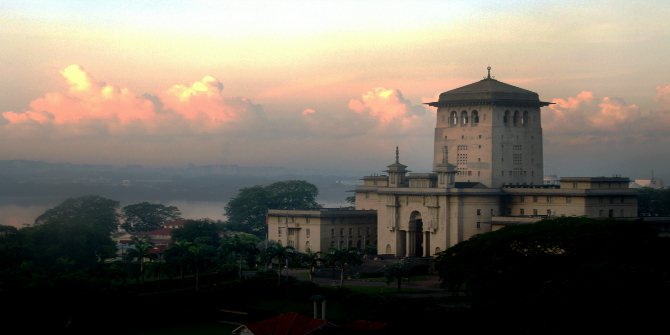 Maitreesh Ghatak argues that while growth is necessary for poverty alleviation or improvements in social indicators, it is not sufficient. In order to take advantage of growth opportunities, the poor need access to human capital, the key inputs to which are education and health.
Maitreesh Ghatak argues that while growth is necessary for poverty alleviation or improvements in social indicators, it is not sufficient. In order to take advantage of growth opportunities, the poor need access to human capital, the key inputs to which are education and health.
The duality of the Gujarat model – high levels of per capita income and high rates of growth with low levels of social indicators and slow rates of improvement – is once again in the news. A news report in The Economist suggests that the Government of India is dragging its feet on the release of a study jointly carried out with the UNICEF, perhaps because Gujarat does not come off with flying colours in it. The findings of the Socio-Economic and Caste Census (2011), released around the same time by the Finance Minister, offer a rather gloomy picture of the economic lives of the rural poor in India, raising questions about India’s status as an emerging economic powerhouse.
It seems that our economic policy debate is forever stuck in a rather tedious jugalbandi between two dominant narratives on the state of the Indian economy. One centres around growth and the other around poverty. Anytime one camp talks of double digit growth and catching up with China, the other points out that India fares worse than sub-Saharan Africa or a relatively poor neighbouring country like Bangladesh in certain social indicators. Every upbeat story about India’s growing economic clout seems to be inevitably accompanied by sad string chords bemoaning the abysmal state of India’s social indicators.
If you designed a software to pick up the slant of a piece of writing on the Indian economy, “growth” and “reforms” would be the keywords for the first school of thought and “poverty” and “inequality” for the second. As with any debate, each side ends up caricaturing the other. Any mention of poverty or human development and you will be called a jholawalla or a socialist who somehow does not understand the magical power of growth to lift people out of poverty or has a vested interest in keeping the poor in poverty (perhaps to attract NGO funds!). Any mention of growth or reform, and you are likely to be called neo-liberal or free-marketeer or to paraphrase a recent political slogan, a suit-bootwalla who is lobbying for reforms that will only help big corporations make more profits at the expense of the poor, who either does not care about poverty or believes in the voodoo economics of trickle down.
In theory, differences in these two narratives could reflect differences in goals or priorities. However, in the Indian context, it is rare to find an economist or commentator who espouses growth for growth’s sake or with no mention, however cursory, of its role in reducing poverty. For example, if one actually reads the books by Jagdish Bhawgati and Amartya Sen that formed the basis of the sizzling Sen-Bhagwati debate a few monsoons ago, it is clear both consider poverty alleviation as a key objective. Where they differ is in their views of how the economy works and what set of policies are likely to be the most effective in achieving the objective.
The problem with the growth-based narrative is that, while growth is necessary for poverty alleviation or improvements in social indicators, it is not sufficient. For example, take the dream growth rate of 10%. It will take twenty-six years of sustained growth of 10% per year in incomes (no country in history has had a quarter century of sustained double digit growth!) to bring an Indian who is right on the poverty line up to merely the current level of per capita income, which is low by global standards to start with. Growth can bring achchhe din, but you would have to wait for a quarter of a century for even a glimmer of that!
The problem with the redistribution-based narrative is that, if you focus just on redistribution, it would hardly make a dent on poverty. Yes, as attractive it may sound to some to tax the rich, if we take the ratio of total billionaire wealth to GDP, it stood at only 10% in 2012 (starting with 1% in the mid-90s). If we took all of this wealth, and divided it among the poor (350 million Indians), each will get roughly the same as the amount marking the current poverty line (roughly $450 per year), and more importantly, this will be a one-time affair!
Growth is indeed necessary for long term poverty alleviation and the suit-bootwallas have that bit correct. But to take advantage of growth opportunities, the poor need access to human capital, the key inputs to which are education and health. While it is true that in the post-liberalisation era growth has indeed lifted millions out of poverty, it is also true that the extent to which growth has made a dent on poverty (growth elasticity of poverty being the technical term) has been lower in India than in China and other comparable countries. This is mainly because of the shockingly low levels of human capital for a large chunk of the population. The jholawallas are right to harp on this.
Consider this fact: the wage rate more than doubles if you move from low-skilled to medium-skilled jobs, or if you move from medium-skilled to high skilled jobs. If the child of an unskilled worker becomes highly skilled, then individual income will increase four-times within one generation. Yet, as a recent report by the Pew Research Center points out, between 2001 and 2011 the share of Indians who would be considered middle income increased from 1% to 3%, whereas in China it went up from 3% to 18%. While poverty has fallen, instead of an emerging middle class, what India has experienced is a larger class of low income earners.
Indeed, the fact that suit-boot ki sarkar became an attacking political slogan is a sign of lack of sufficient inter-generational mobility in our society, in terms of occupation and economic status. While there has been some increase in mobility, if a sufficient number of children from poorer sections were expected to land high-skilled jobs wearing suits and boots, the slogan would not have any sting.
The key to sustained increases in standard of living is therefore to foster mobility through investments in human capital. Markets create opportunities for those with human capital and it is the responsibility of the government to ensure that the poor acquire the human capital necessary to take advantage of these opportunities. Investing in the human capital of children is therefore a win-win strategy – it helps achieve both higher growth rates and reduces poverty and removes the apparent tension between these objectives as implied by the growth versus redistribution debate.
It is in this context that one has to view the cuts in social sector spending in the latest budget with concern. Defenders will point to the greater resources given to states following the recommendation of the 14th Finance Commission. But we cannot ignore the reality of wide variation in the performance of different states in measures of human development, and their governance capacity (recall that all the recent corruption scandals have to do with state governments). Unless accompanied by an appropriate monitoring and evaluation framework, with rewards accompanying better performance, mere decentralisation in budgetary allocation is not sufficient.
However, budgetary allocation is only a necessary condition for effective investment in human capital. For example, if we look at actual learning outcomes as captured by ASER reports, it is clear that simply pumping in more money is not going to solve all the problems, and that major reforms in the institutions of social service delivery are essential. This should be one of our top policy priorities.
It is time to move beyond the stale growth versus redistribution debate and to focus on economic mobility. Let us judge policies, including those that are aimed at growth or redistribution, in terms of their impact on enhancing mobility. Rather than jholas or suit-boots, let’s talk about schoolbags and school uniforms.
A version of this article originally appeared 20 July 2015 on the NDTV website.
Note: This article gives the views of the author, and not the position of the South Asia @ LSE blog, nor of the London School of Economics. Please read our comments policy before posting.
About the Author
 Maitreesh Ghatak is Professor of Economics at the LSE. He is Lead Academic on the IGC India-Bihar country team and Economic Organisation and Public Policy Programme Director at STICERD.
Maitreesh Ghatak is Professor of Economics at the LSE. He is Lead Academic on the IGC India-Bihar country team and Economic Organisation and Public Policy Programme Director at STICERD.
Professor Ghatak is a regular contributor to South Asia @ LSE. Read his previous posts here.








” For example, take the dream growth rate of 10%. It will take twenty-six years of sustained growth of 10% per year in incomes (no country in history has had a quarter century of sustained double digit growth!) to bring an Indian who is right on the poverty line up to merely the current level of per capita income, which is low by global standards to start with.”
There’s a large fallacy here. The real rate of growth for the poorest might well be greater than the real rate of growth for the better off.